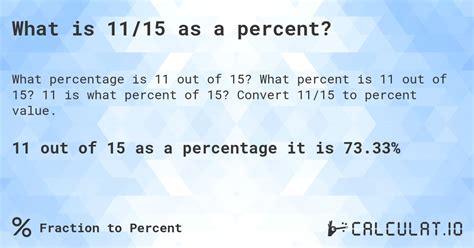What Is 11 Out Of 15 As A Percentage
Kalali
Apr 05, 2025 · 4 min read

Table of Contents
What is 11 out of 15 as a Percentage? A Comprehensive Guide
Calculating percentages is a fundamental skill with widespread applications in various aspects of life, from academic pursuits to professional settings and even everyday situations. Understanding how to express fractions as percentages is crucial for interpreting data, making comparisons, and understanding proportions. This comprehensive guide will delve into the process of determining what 11 out of 15 represents as a percentage, explaining the methodology in detail and providing valuable insights into percentage calculations.
Understanding Percentages
Before we dive into the specifics of converting 11 out of 15 into a percentage, let's establish a foundational understanding of percentages themselves. A percentage is simply a fraction or ratio expressed as a number out of 100. The term "percent" literally means "out of one hundred" – the word "per" implies division and "cent" refers to one hundred. Therefore, a percentage represents a portion or proportion of a whole.
Representing Percentages
Percentages can be represented in several ways:
- Decimal form: 0.75 (representing 75%)
- Fraction form: ¾ (representing 75%)
- Percentage form: 75%
Understanding these different representations is key to working comfortably with percentages. Converting between these formats is a crucial skill for accurate calculations.
Calculating 11 out of 15 as a Percentage: Step-by-Step
To determine what 11 out of 15 represents as a percentage, we'll follow a simple yet effective three-step process:
Step 1: Formulate the Fraction
First, express the given information as a fraction. In this case, "11 out of 15" translates directly to the fraction 11/15. This fraction represents the ratio of the part (11) to the whole (15).
Step 2: Convert the Fraction to a Decimal
To convert the fraction 11/15 to a decimal, we divide the numerator (11) by the denominator (15):
11 ÷ 15 ≈ 0.7333
The result is an approximate decimal value because the division produces a repeating decimal. We'll use this approximate value for our percentage calculation.
Step 3: Convert the Decimal to a Percentage
To convert the decimal value to a percentage, multiply it by 100 and add the "%" symbol:
0.7333 x 100 ≈ 73.33%
Therefore, 11 out of 15 is approximately 73.33%.
Alternative Calculation Methods
While the above method is straightforward, there are alternative approaches to calculating percentages, each offering a slightly different perspective:
Method 1: Using Proportions
We can use proportions to solve this problem. We set up a proportion where x represents the percentage we're trying to find:
11/15 = x/100
To solve for x, we cross-multiply:
15x = 1100
x = 1100/15
x ≈ 73.33
This confirms our previous result.
Method 2: Using a Calculator
Most calculators have a percentage function that simplifies the process. Simply input 11/15 and then use the percentage function to directly obtain the result. This method eliminates the need for manual decimal-to-percentage conversion.
Practical Applications of Percentage Calculations
The ability to calculate percentages is invaluable across numerous fields and daily life scenarios. Here are a few examples:
- Academic Performance: Calculating grades, assessing test scores, and evaluating overall academic progress. For instance, if a student answered 11 out of 15 questions correctly on a test, their score would be 73.33%.
- Financial Management: Determining interest rates, calculating discounts, analyzing investment returns, and understanding tax rates. Percentage calculations are fundamental to personal finance and business accounting.
- Statistical Analysis: Interpreting survey results, analyzing data sets, and visualizing proportions within a larger group. Understanding percentages is crucial for drawing meaningful conclusions from data.
- Sales and Marketing: Calculating profit margins, evaluating sales performance, and determining discount offers. Businesses heavily rely on percentage calculations for their operational success.
- Everyday Life: Calculating tips, splitting bills, determining sale prices, and understanding nutritional information on food labels. Percentages are seamlessly integrated into our daily interactions.
Beyond the Basics: Working with More Complex Percentages
While 11 out of 15 is a relatively straightforward calculation, understanding percentages involves more complex scenarios:
- Percentage Increase/Decrease: Calculating the percentage change between two values. For instance, if a price increases from $10 to $15, the percentage increase is 50%.
- Compound Percentages: Calculating percentages based on previous percentage results. This is common in compound interest calculations where interest earns interest.
- Percentage Points: Understanding the difference between percentage change and percentage points. A change from 10% to 20% is a 10 percentage point increase, but a 100% increase.
Mastering these more advanced concepts broadens the application of percentage calculations.
Conclusion: The Importance of Percentage Literacy
Understanding how to calculate percentages, as demonstrated through the example of 11 out of 15, is a vital skill applicable to numerous facets of life. From academic achievements to financial decisions and professional endeavors, the ability to convert fractions and decimals to percentages and vice versa allows for better comprehension, analysis, and decision-making. Continuously practicing percentage calculations and exploring more complex scenarios will solidify your understanding and make you more confident in tackling various quantitative challenges. By mastering percentages, you unlock a powerful tool for navigating the numerical world. Remember, consistent practice is key to developing proficiency and confidence in handling percentages.
Latest Posts
Latest Posts
-
What Is 2 6 As A Percent
Apr 06, 2025
-
2 Out Of 8 Is What Percent
Apr 06, 2025
-
What Is 110 Minutes In Hours
Apr 06, 2025
-
103 Cm Is How Many Inches
Apr 06, 2025
-
What Is Lcm Of 6 And 7
Apr 06, 2025
Related Post
Thank you for visiting our website which covers about What Is 11 Out Of 15 As A Percentage . We hope the information provided has been useful to you. Feel free to contact us if you have any questions or need further assistance. See you next time and don't miss to bookmark.
